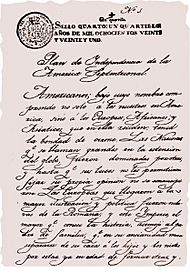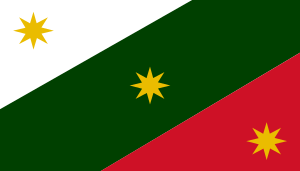Plan of Iguala facts for kids
Quick facts for kids Plan of Iguala |
|
 |
|
| Created | 24 February 1821 |
| Ratified | 24 August 1821 |
| Location | Iguala, Mexico |
| Signers | Agustín de Iturbide, Vicente Guerrero |
| Purpose | Establish the form of Mexican independence |
The Plan of Iguala, also known as the Plan of the Three Guarantees or "Plan Trigarante," was a very important announcement made on February 24, 1821. It happened during the final part of the Mexican War of Independence from Spain. This plan said that Mexico would become an independent country with its own government.
The Plan of Iguala declared that Mexico would be a constitutional monarchy. This means it would have a king or emperor, but their power would be limited by a constitution (a set of rules). The plan also stated that Roman Catholicism would be the only official religion. It made sure that all people in Mexico, including those born in Spain (called Peninsulares) and those of Spanish descent born in Mexico (called Creoles), would have equal political and social rights. The plan was named after the city of Iguala in Mexico.
The two main leaders behind this plan were Agustín de Iturbide and Vicente Guerrero. Iturbide later became the first Emperor of Mexico. Guerrero was a rebel leader who later became President of Mexico. They joined their forces to create the Army of the Three Guarantees. This army was formed to protect the ideas of the Plan of Iguala. On August 24, 1821, Iturbide and the Spanish Viceroy, Juan O'Donojú, signed the Treaty of Córdoba. This treaty officially agreed to the Plan of Iguala and confirmed Mexico's independence.
The Plan of Iguala was a compromise, meaning it combined old ideas with new ones. For example, it created a new army. But it also kept the right for all men to vote, no matter where they came from, their race, or how much money they had. This right was already part of the Constitution of 1812.
What Were the Three Guarantees?
The Plan of Iguala set up three main principles for the new country of Mexico. These are the "Three Guarantees" that give the plan its other name:
- Religion: Roman Catholicism would be the official and only religion.
- Independence: Mexico would be completely free from Spain.
- Unity: All social and ethnic groups in Mexico would have full social equality. This meant everyone was equal, no matter their background.
These three guarantees are often summarized as "Religion, Independence, and Union." The flag of the Army of the Three Guarantees showed these ideas. It had three colors: green, white, and red. These colors are still used in the modern Mexican flag today.
The document made it clear that everyone living in Mexico was a citizen. It said "Americans" included not only people born in America, but also Europeans, Africans, and Asians living there. It also stated that all people in the Mexican Empire could apply for any job, based only on their skills and good character.
What Happened After the Plan?
Even though the Spanish Viceroy agreed to the Treaty of Córdoba, the Spanish government in Madrid did not. On February 13, 1822, the Spanish Congress said the treaty was "illegal, null, and void." However, the Mexican government insisted that O'Donojú's agreement made Mexico's independence official.
Spain tried to take back Mexico several times over the next ten years. But eventually, Spain officially recognized Mexico's independence. This happened on December 28, 1836, with the signing of the Santa María–Calatrava Treaty.
After Agustín de Iturbide's empire ended, the Mexican Congress canceled both the Plan of Iguala and the Treaty of Córdoba on April 8, 1823. Instead, they called for a new meeting to create a new constitution. This led to the adoption of the 1824 Constitution of Mexico on October 4, 1824.
See also
 In Spanish: Plan de Iguala para niños
In Spanish: Plan de Iguala para niños
- Mexican War of Independence
- Declaration of Independence of the Mexican Empire
- Plans in Mexican history
- History of democracy in Mexico


